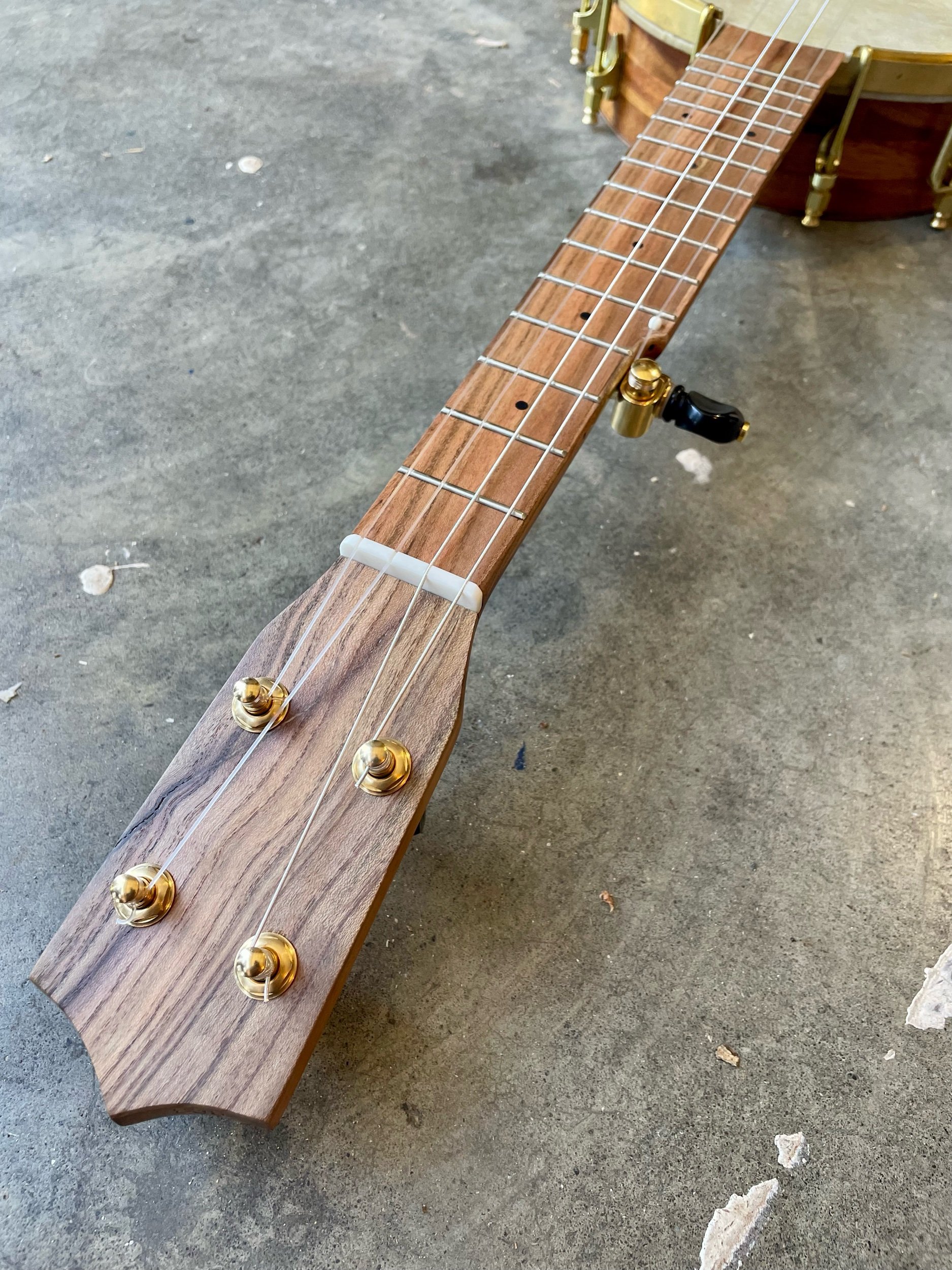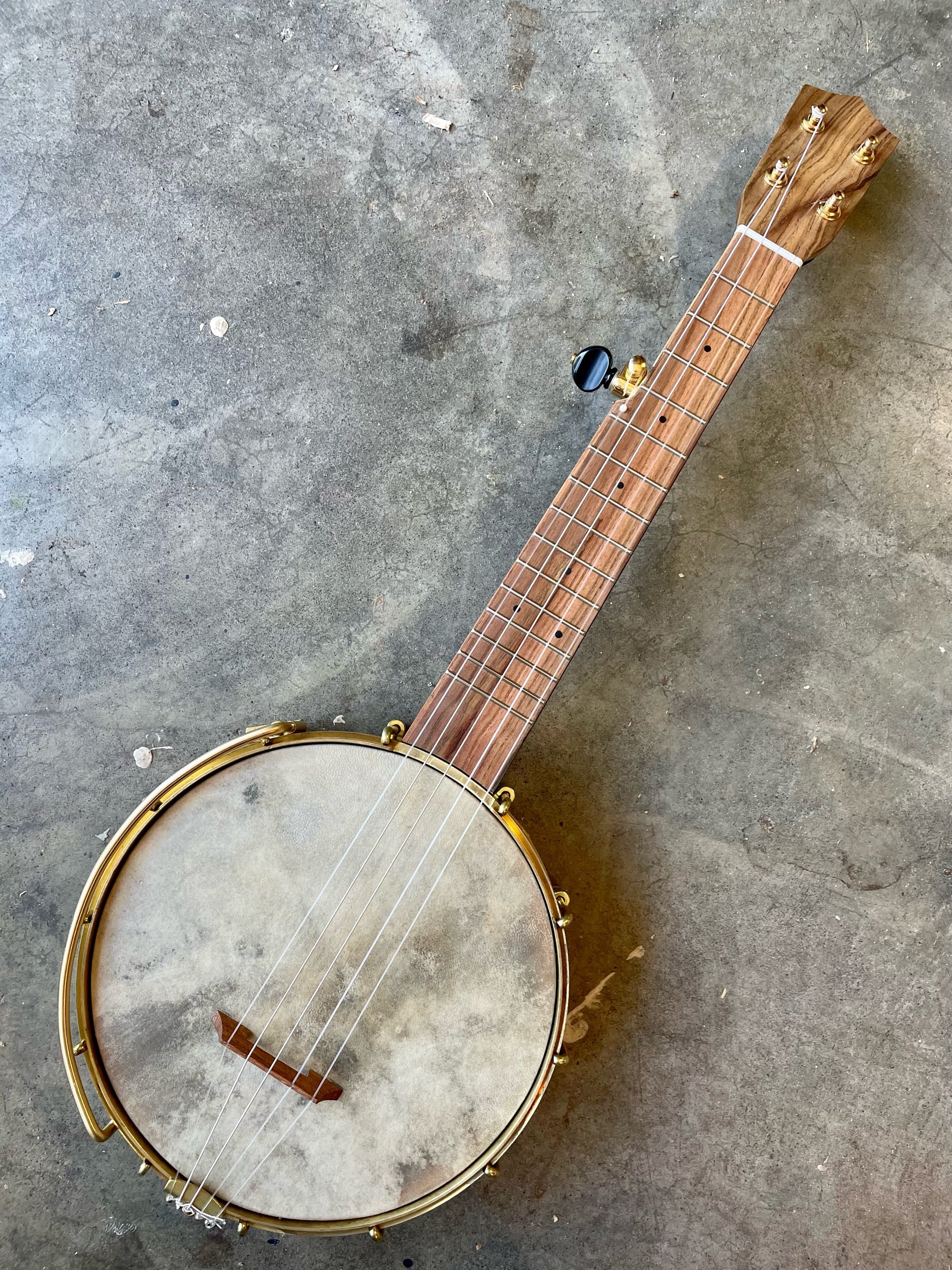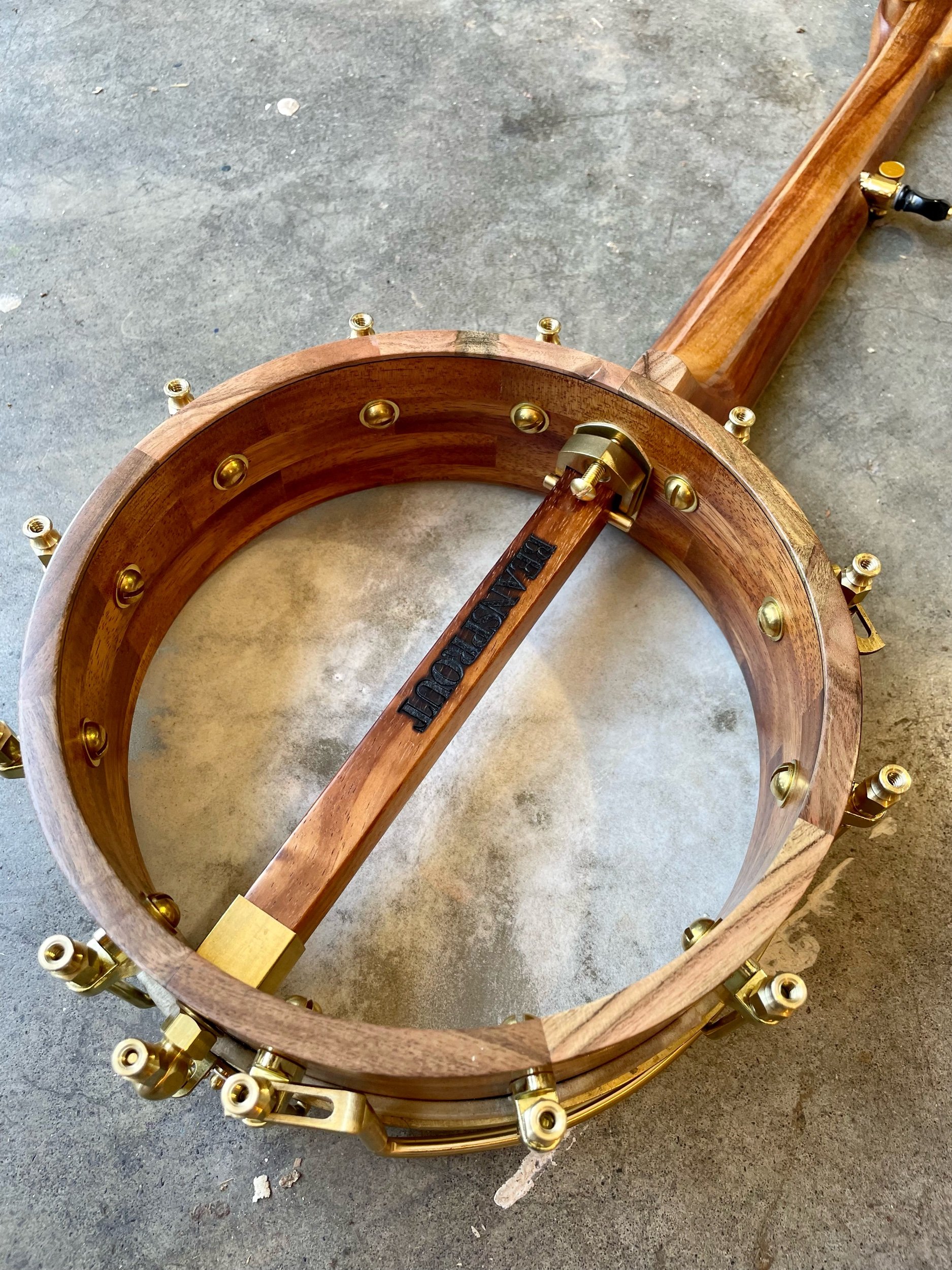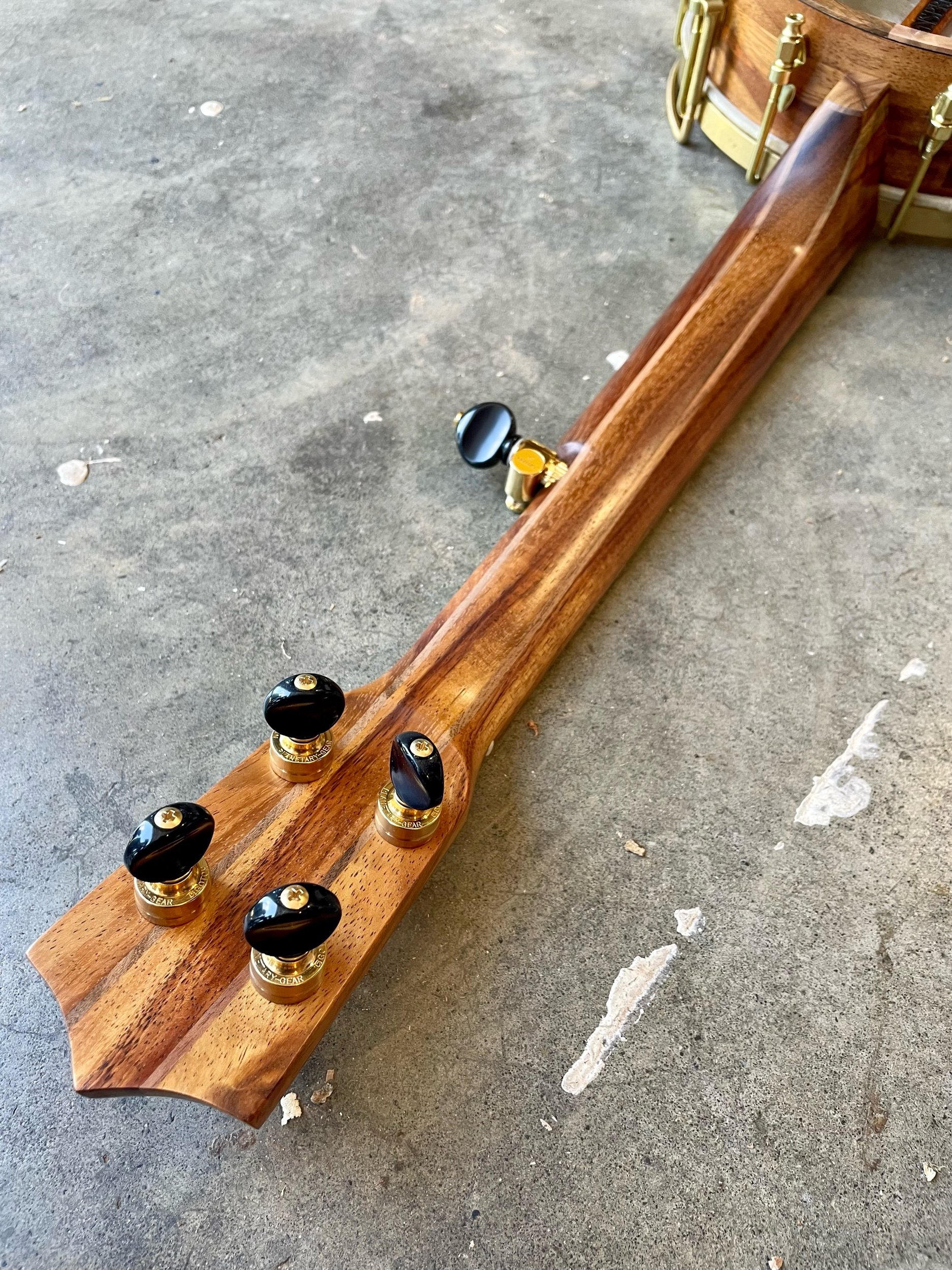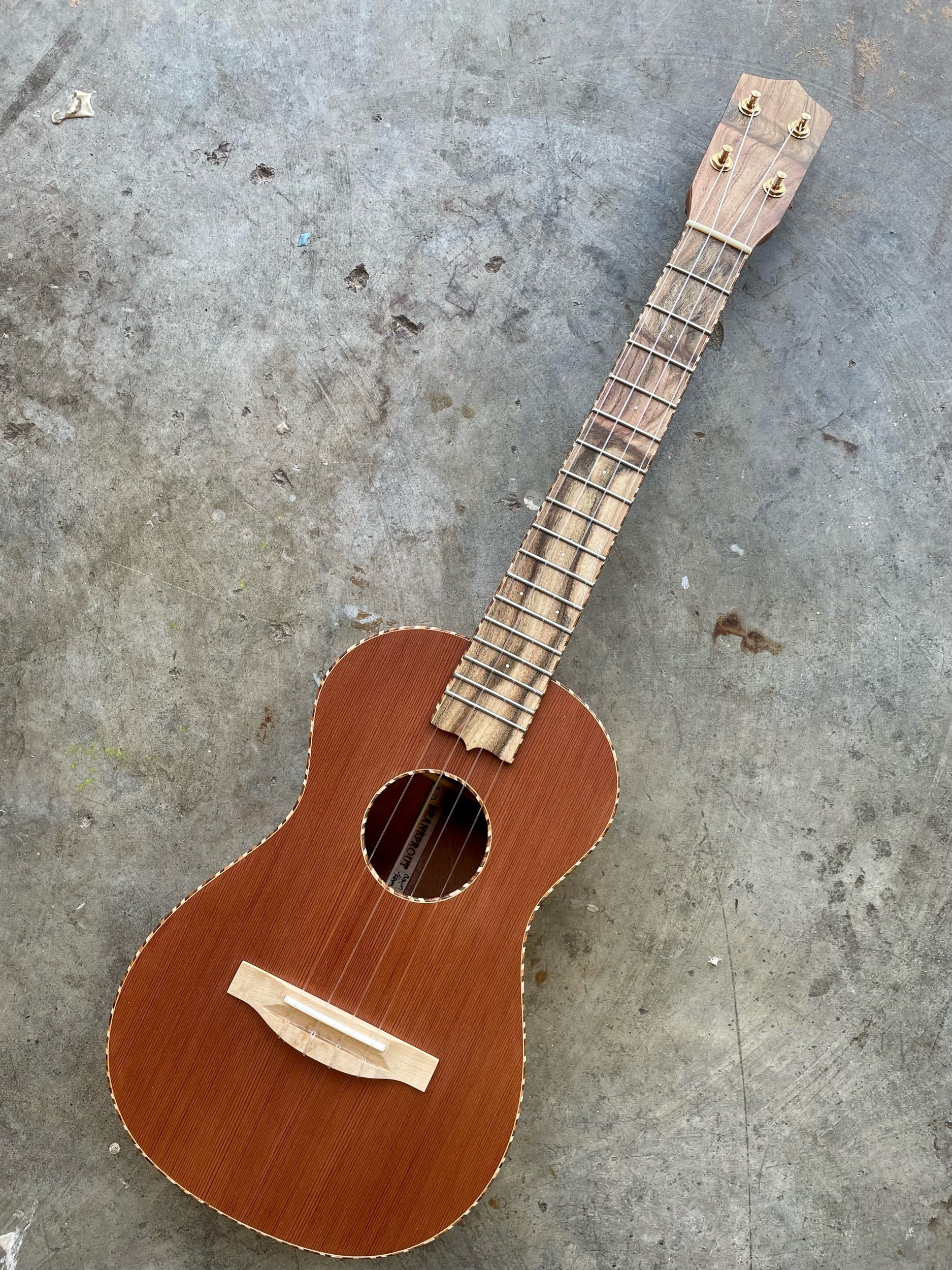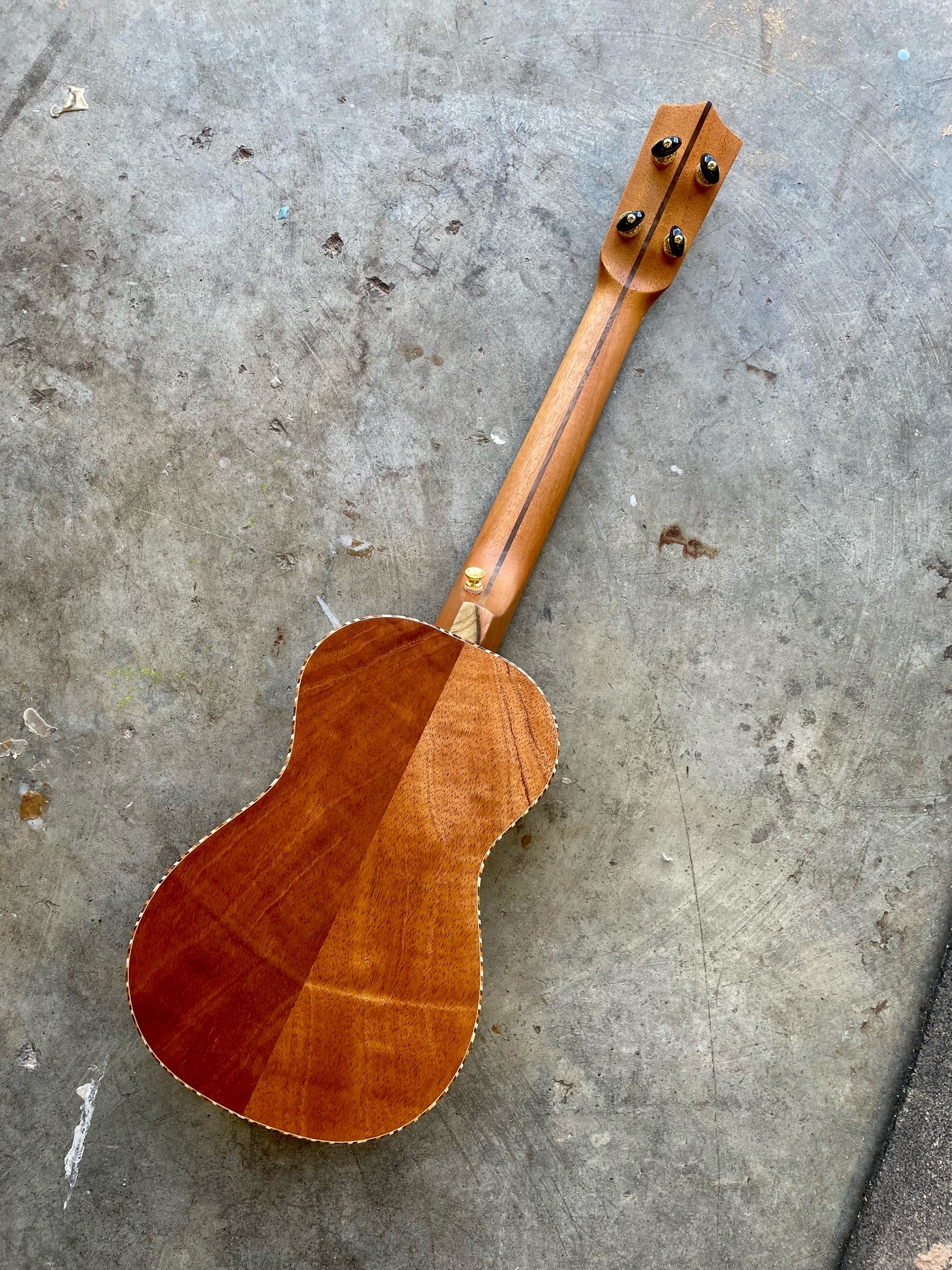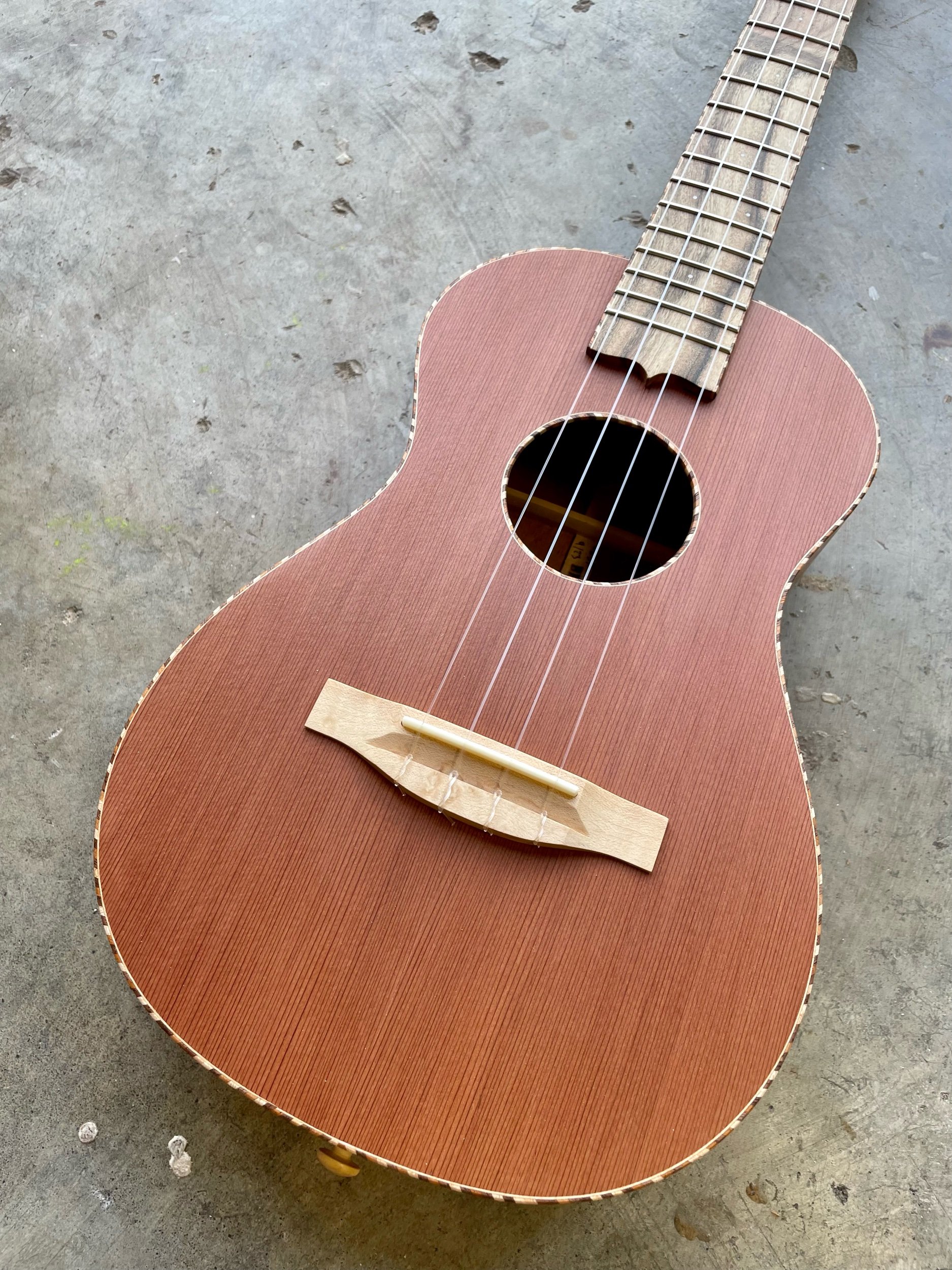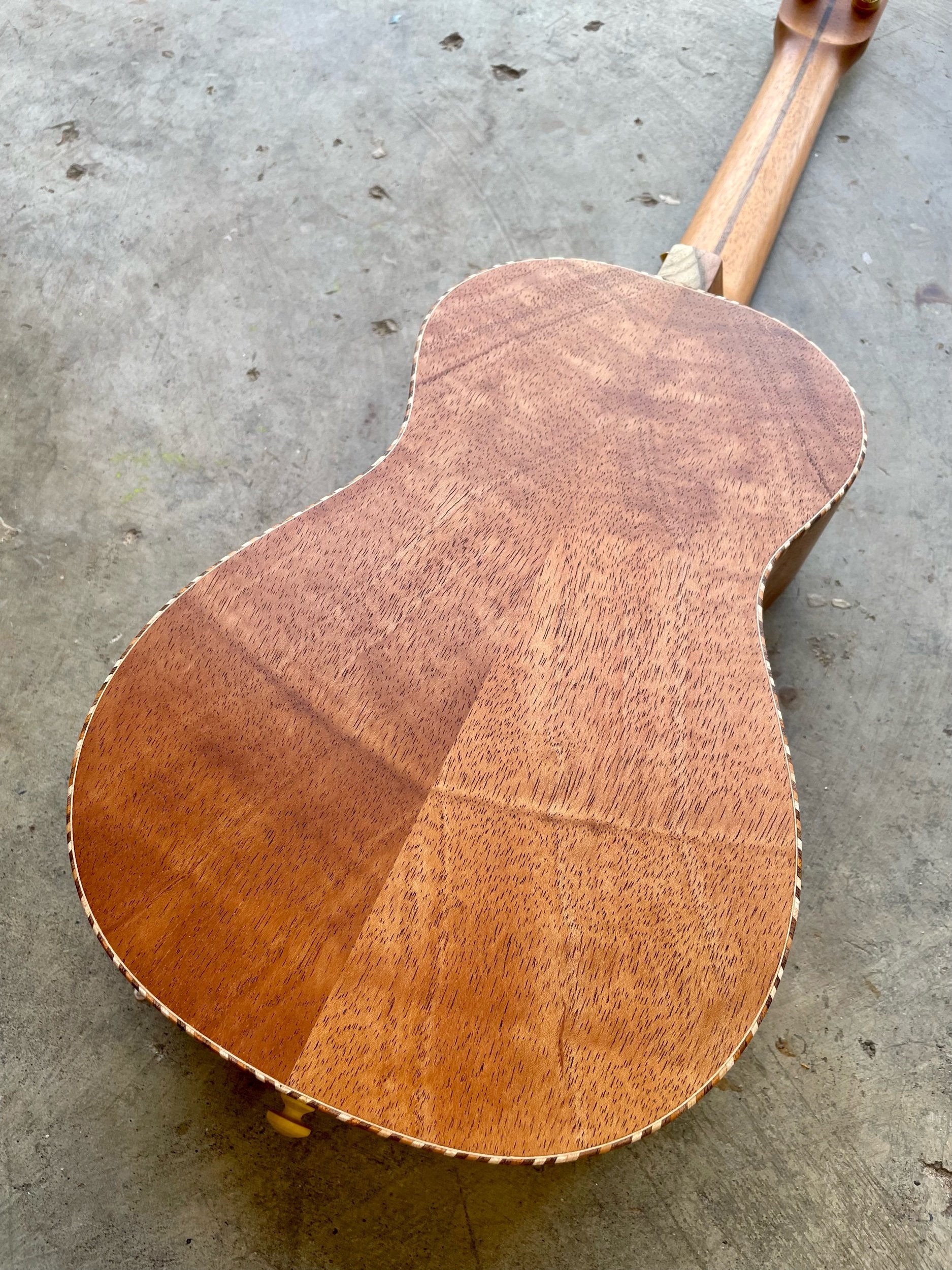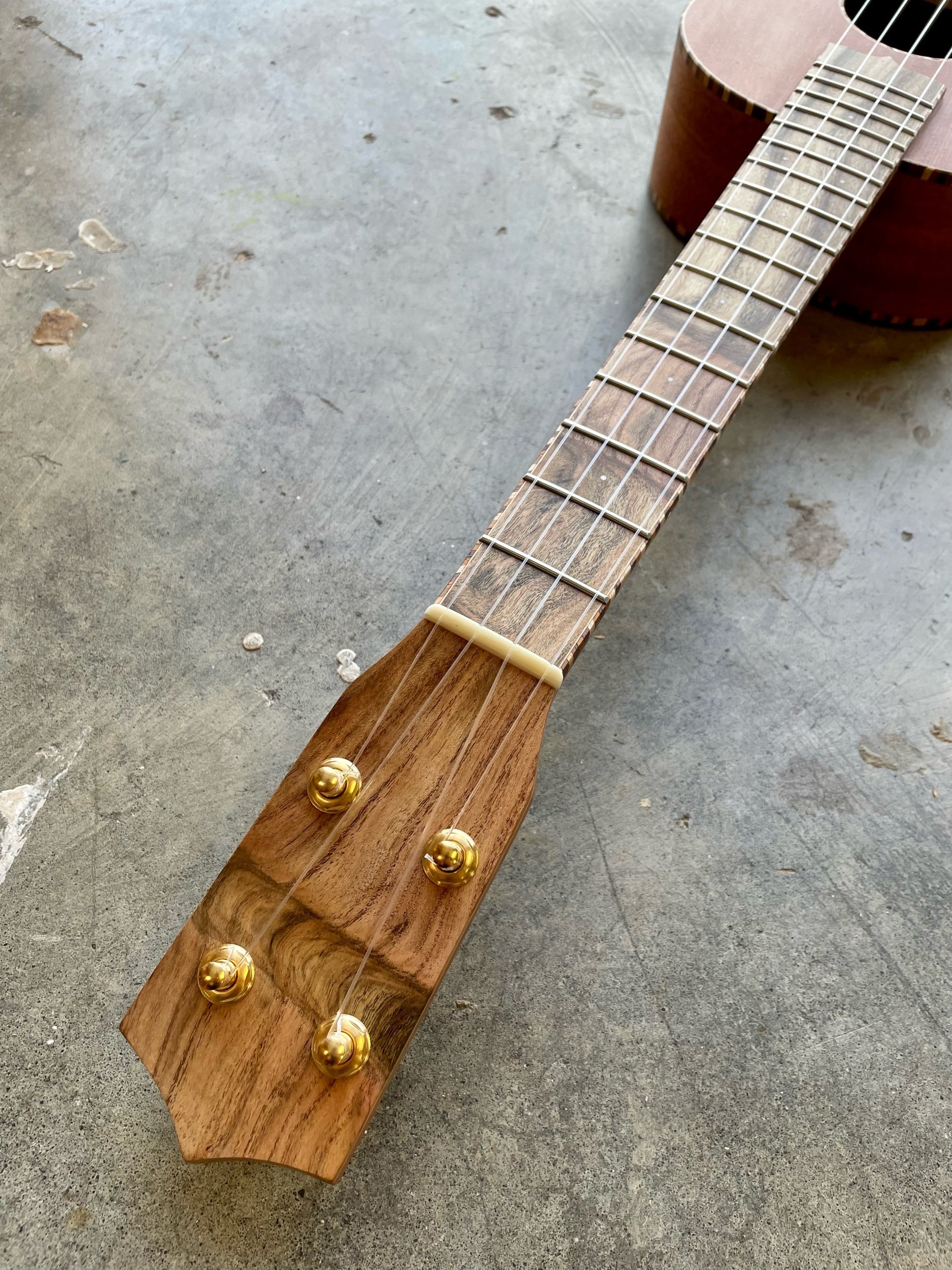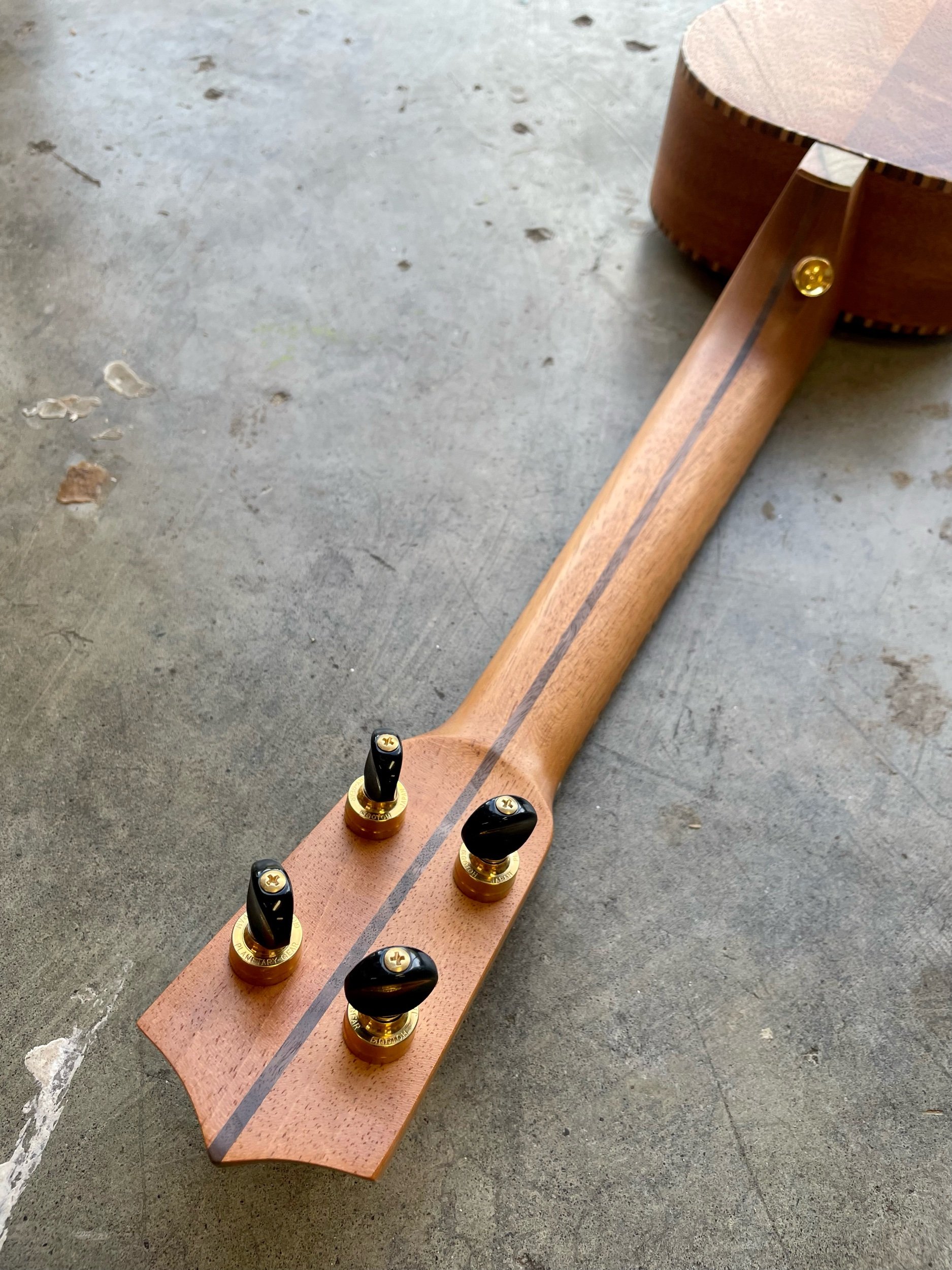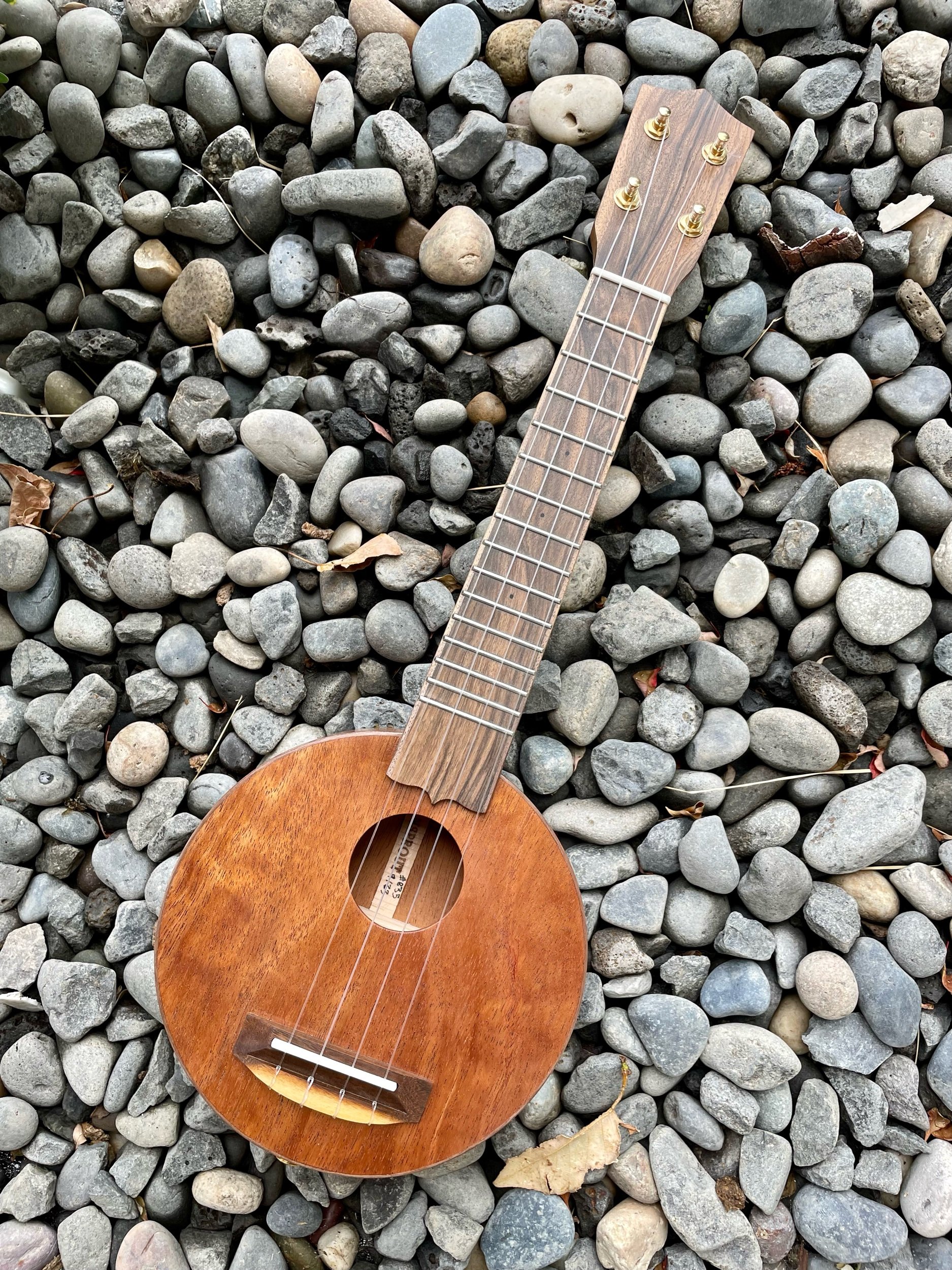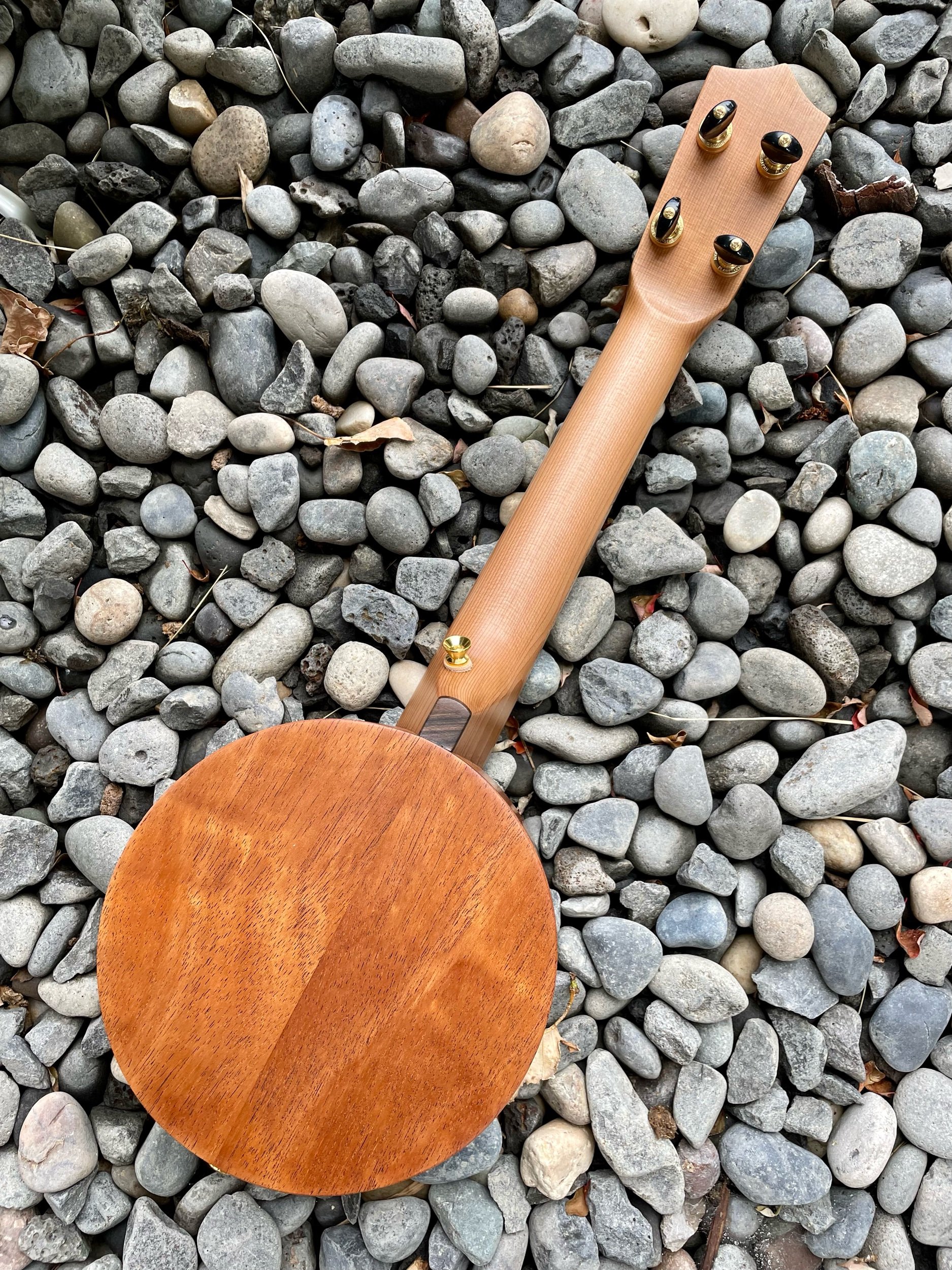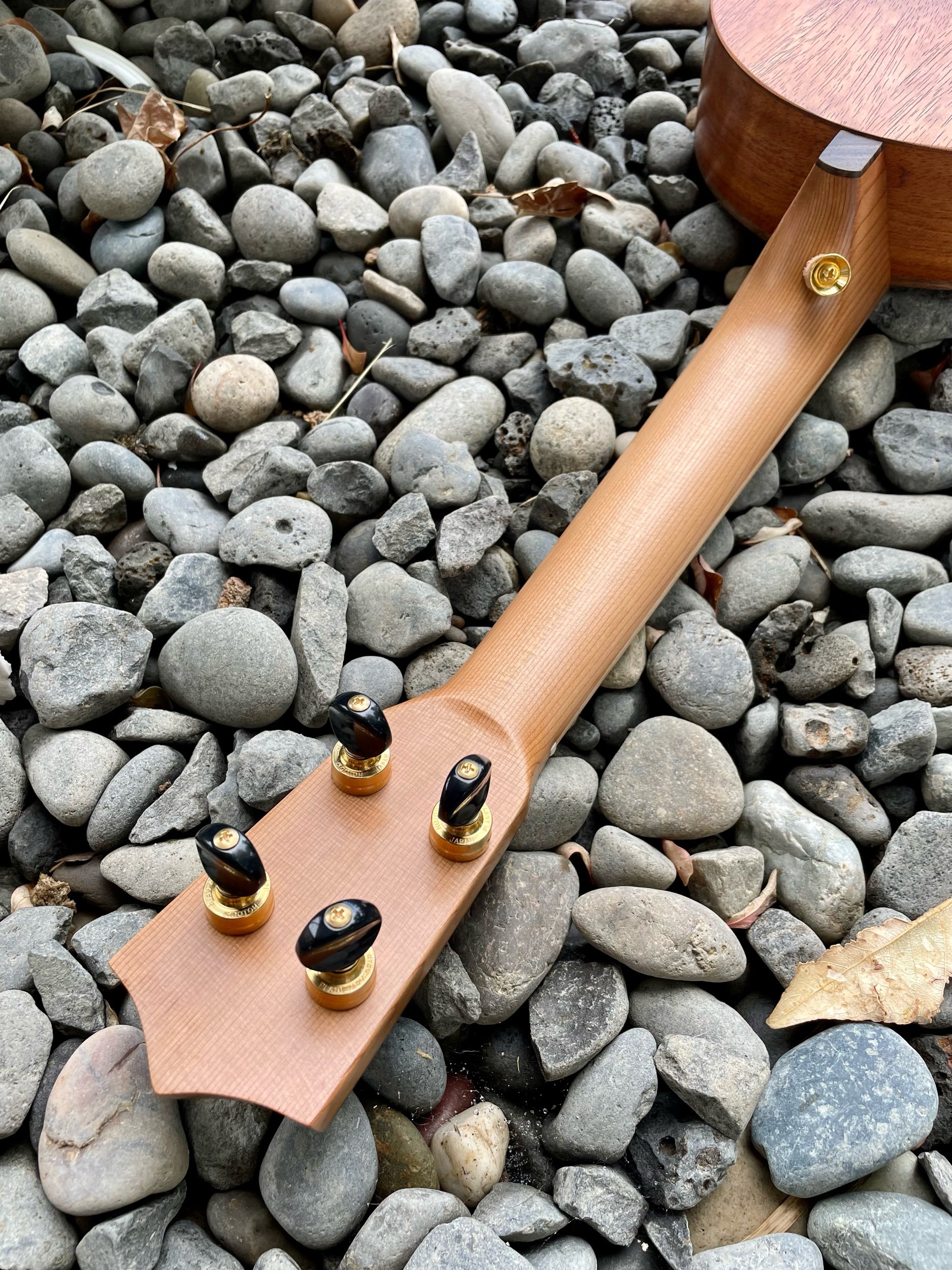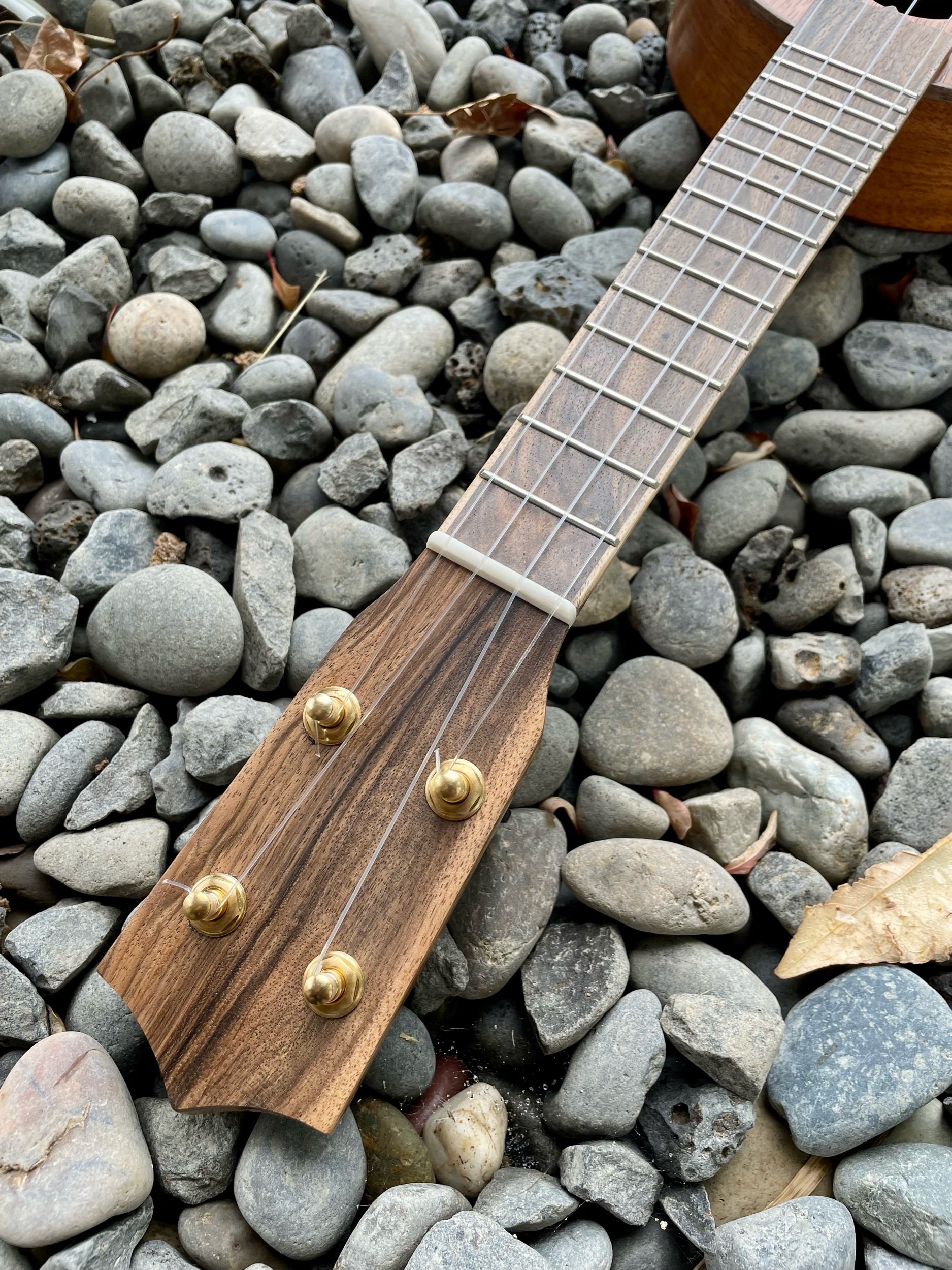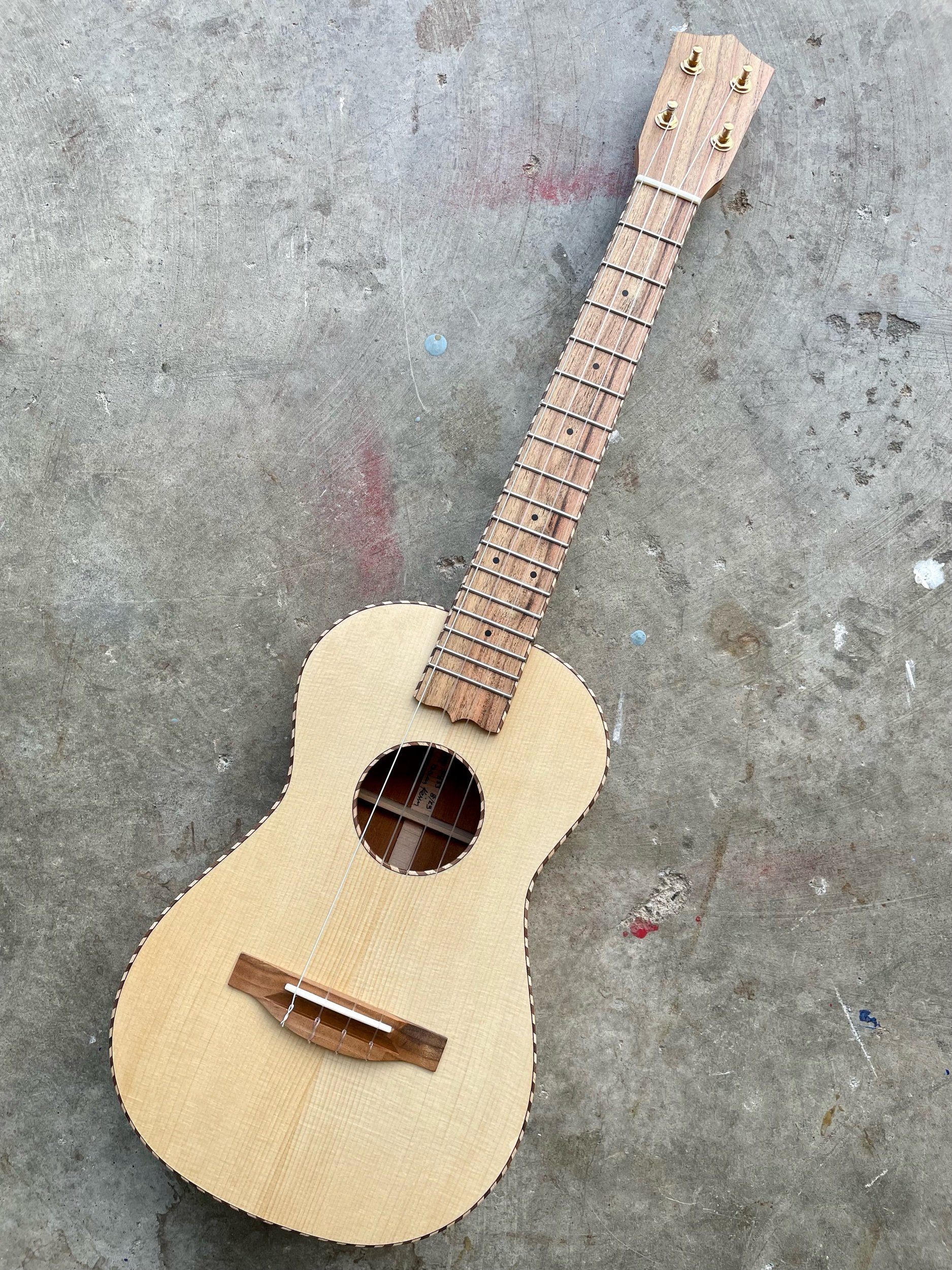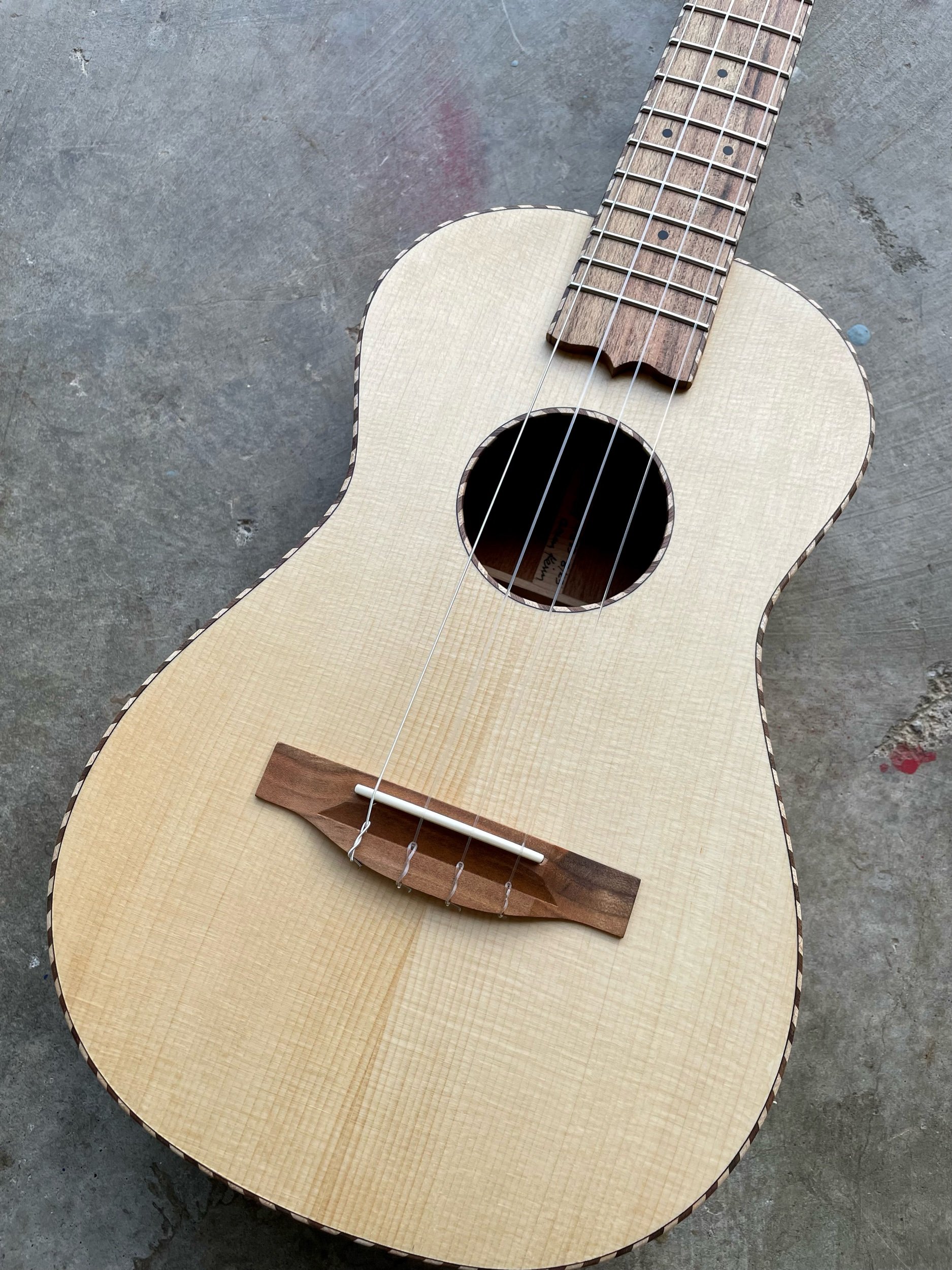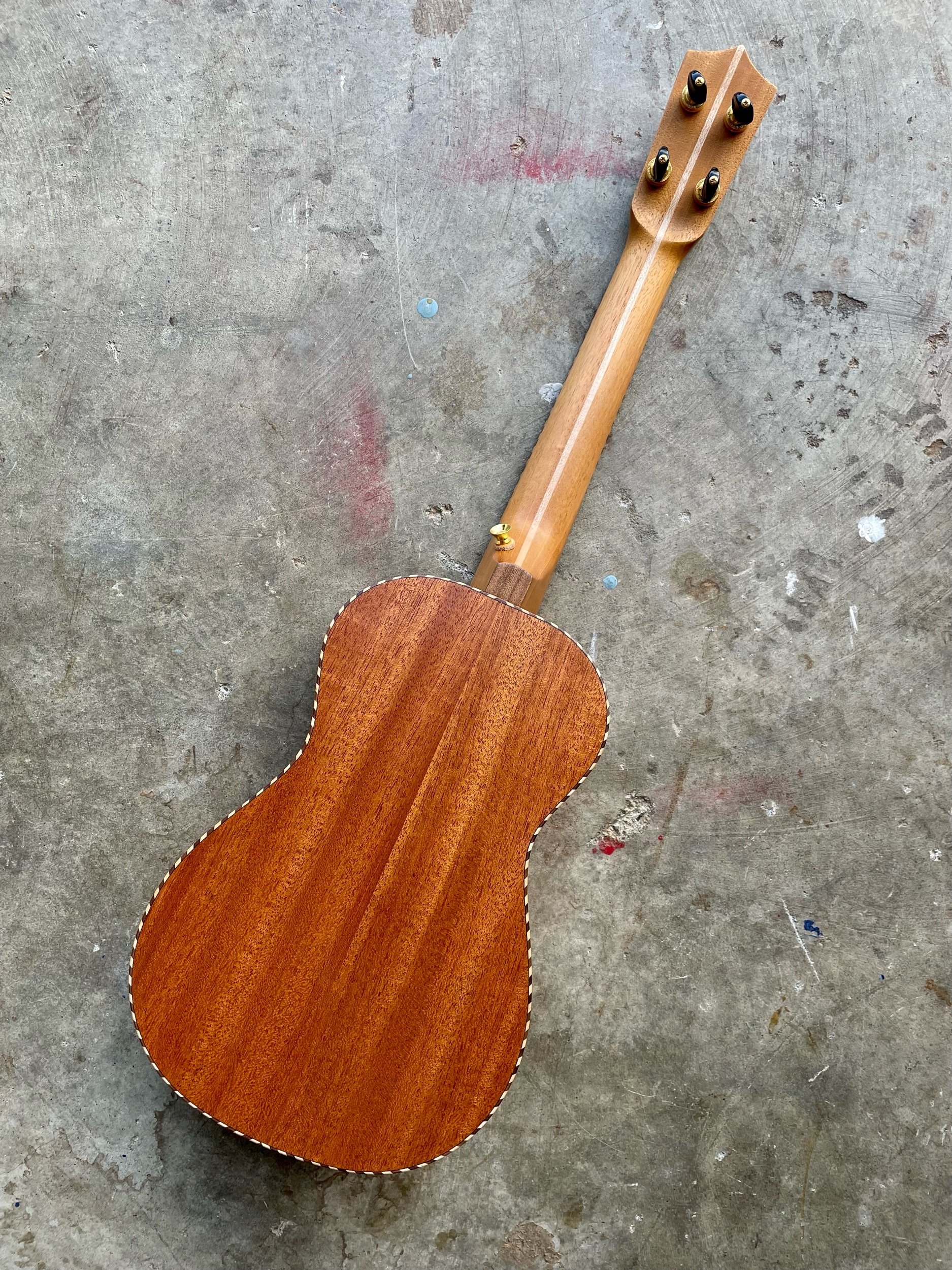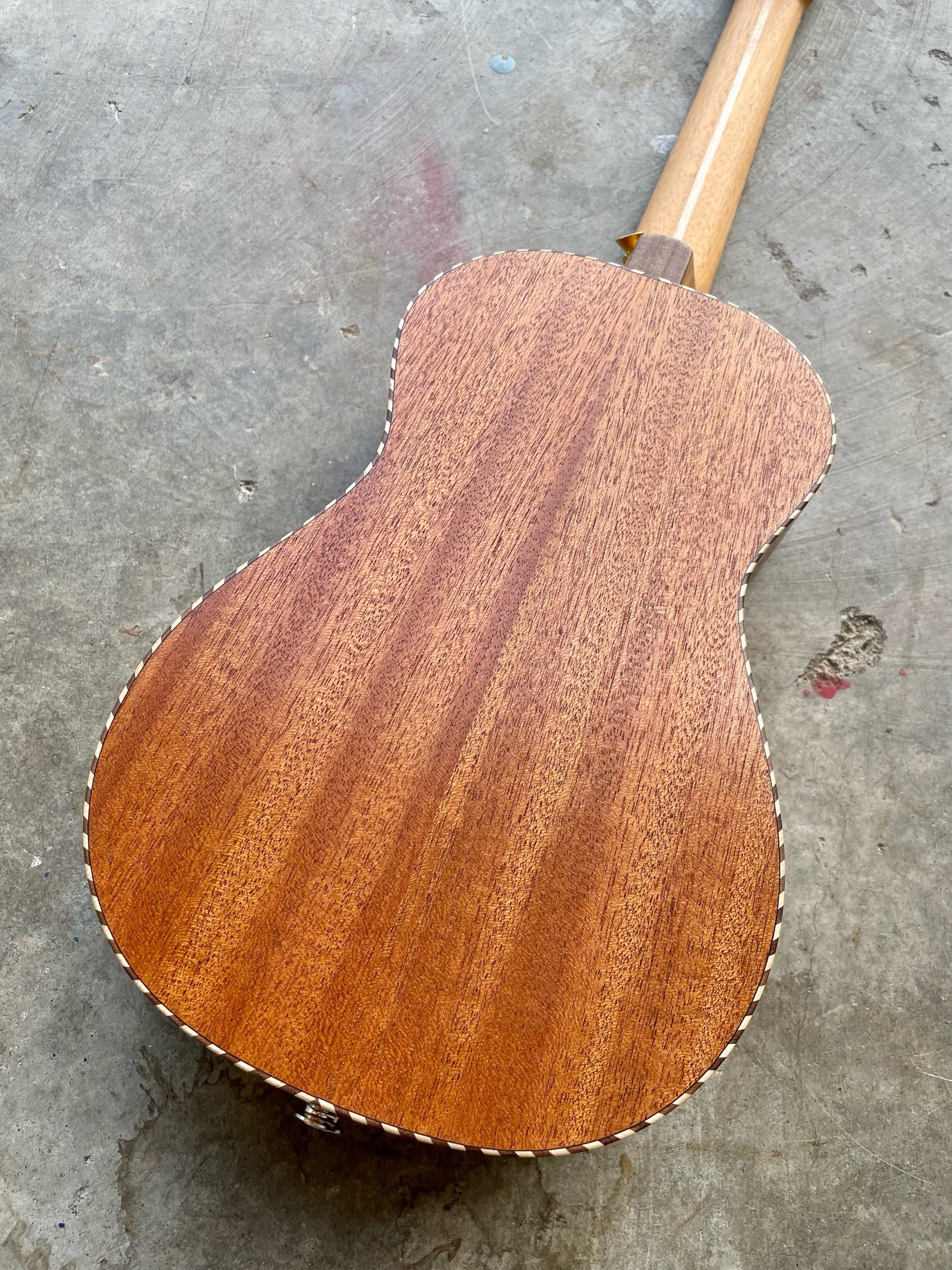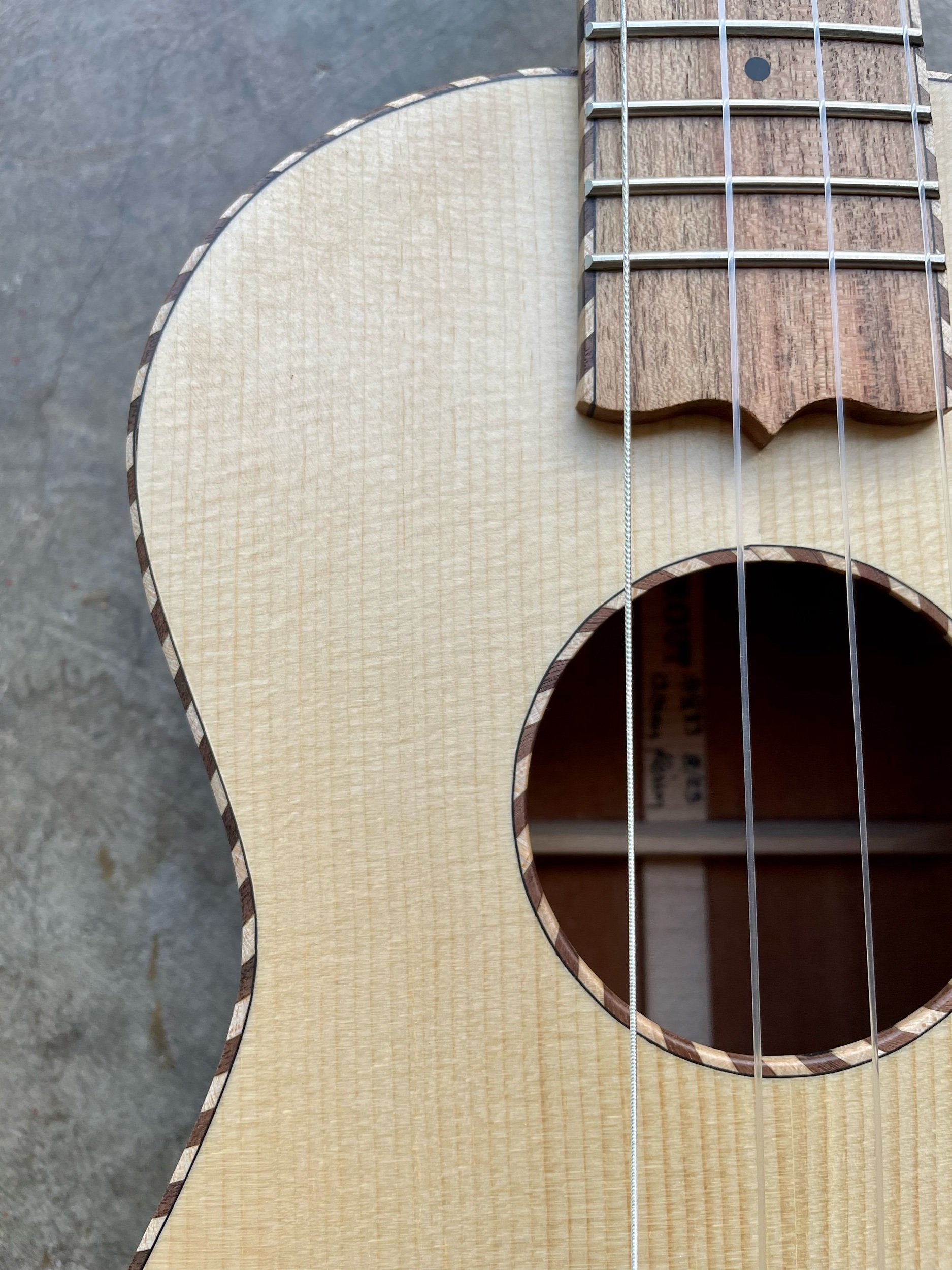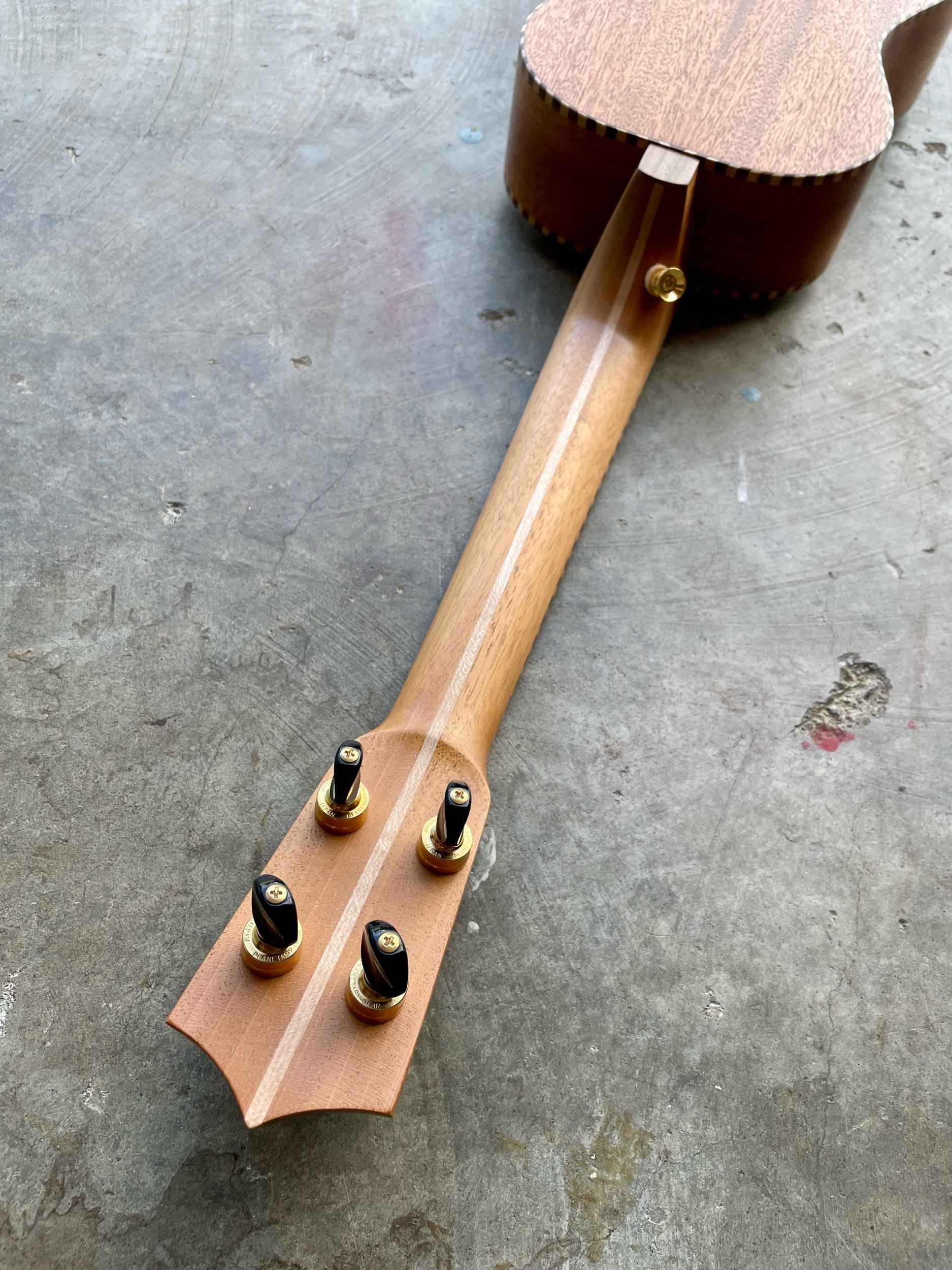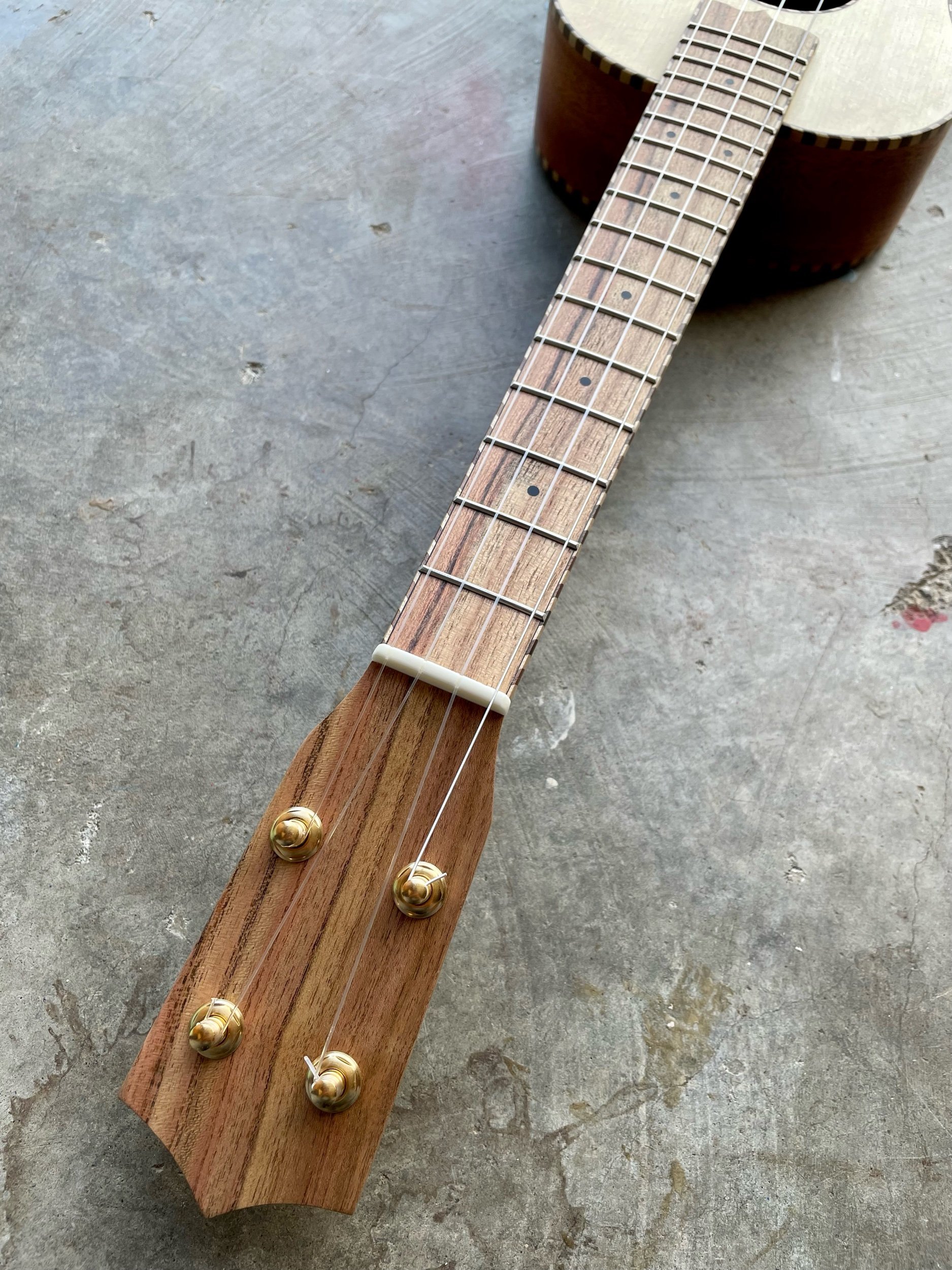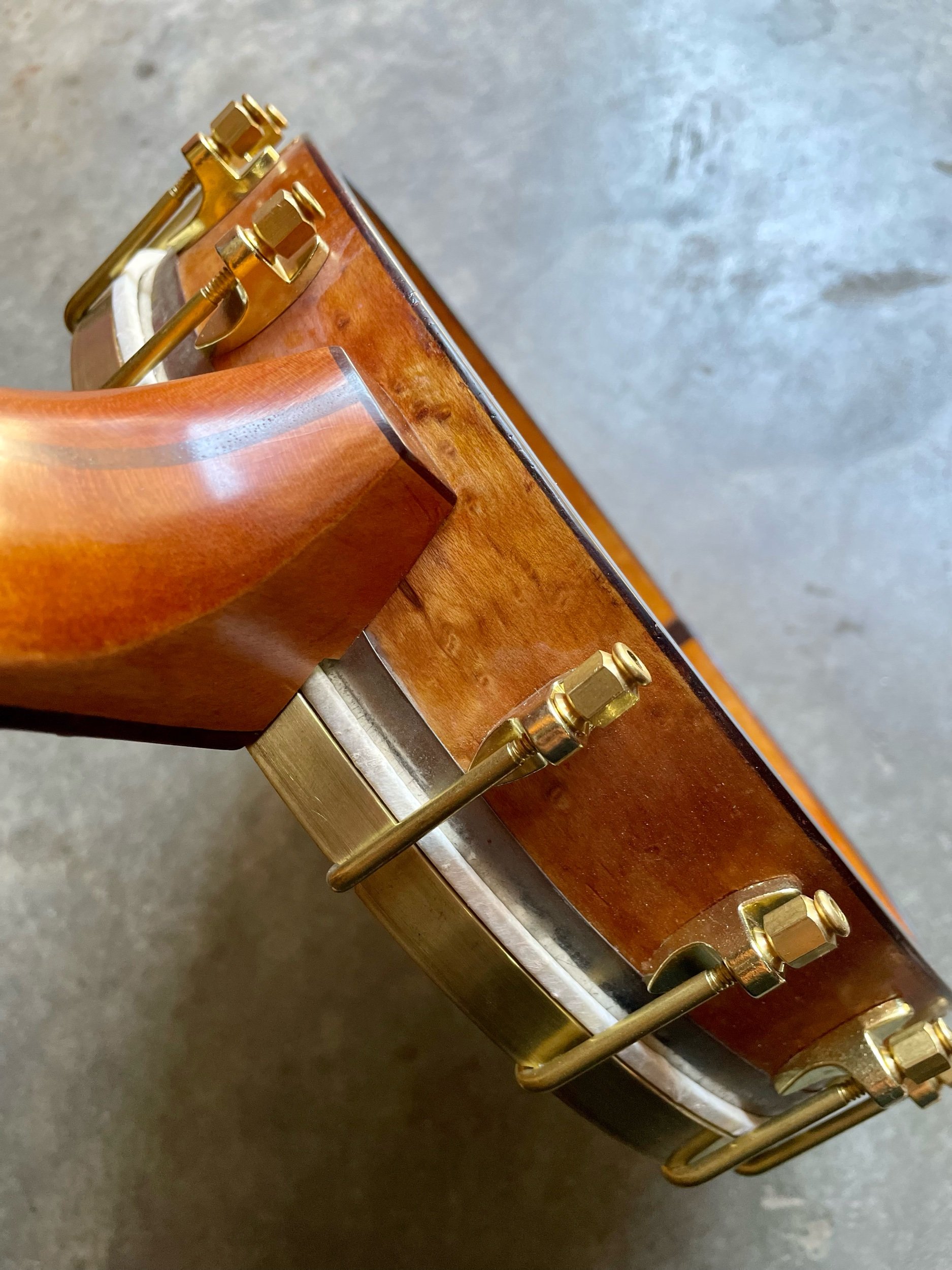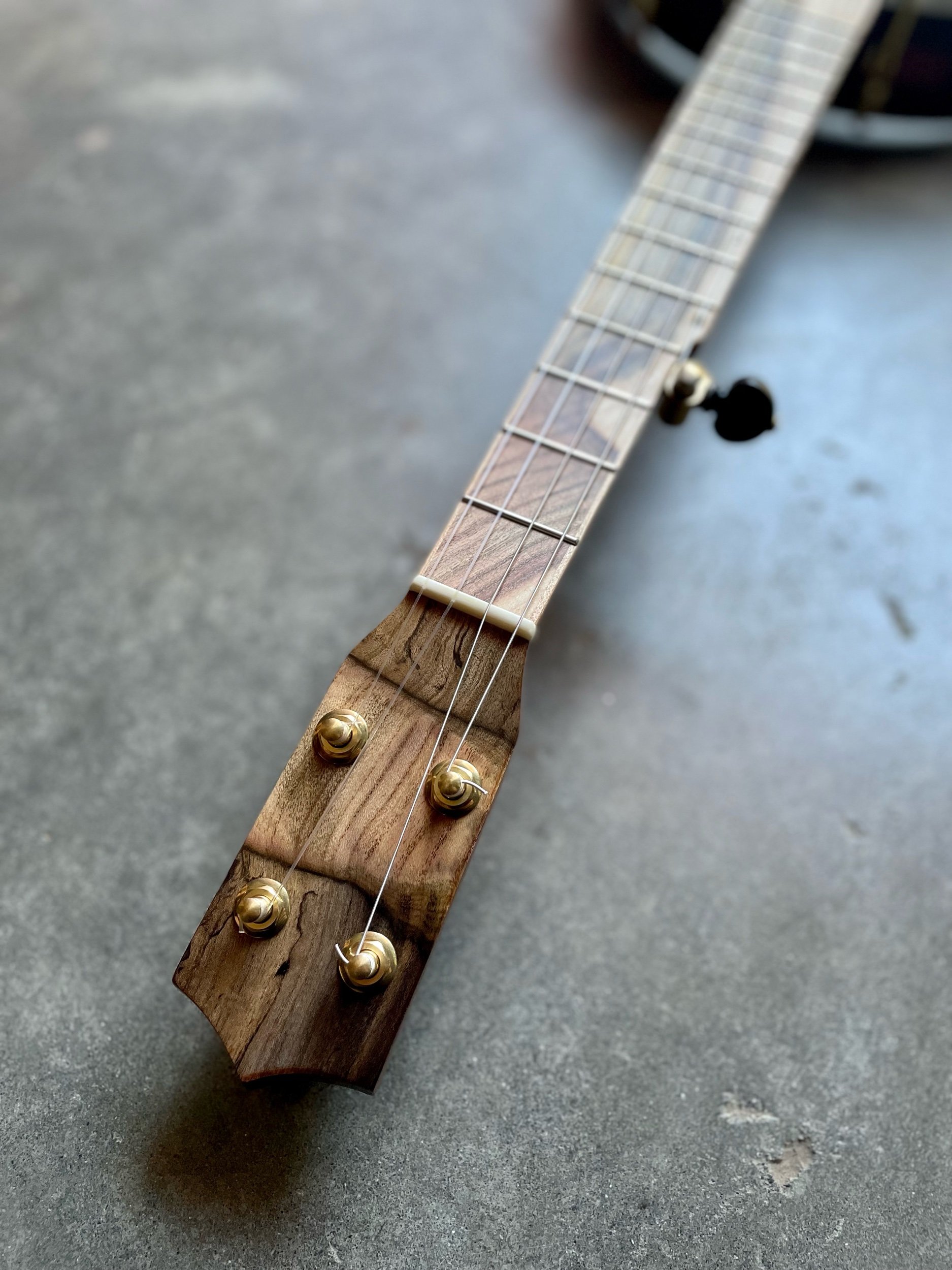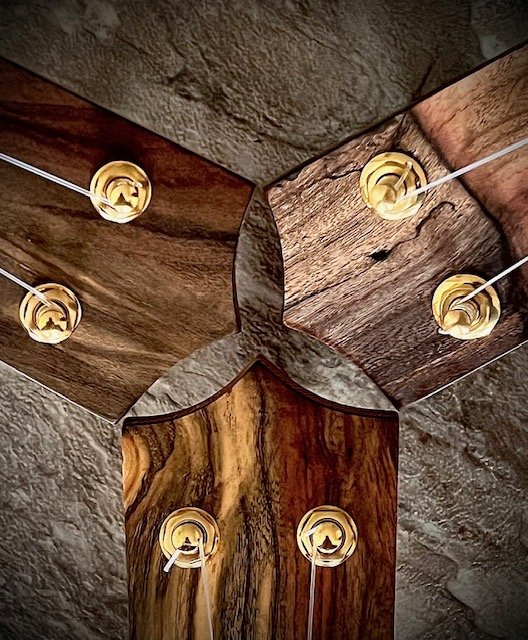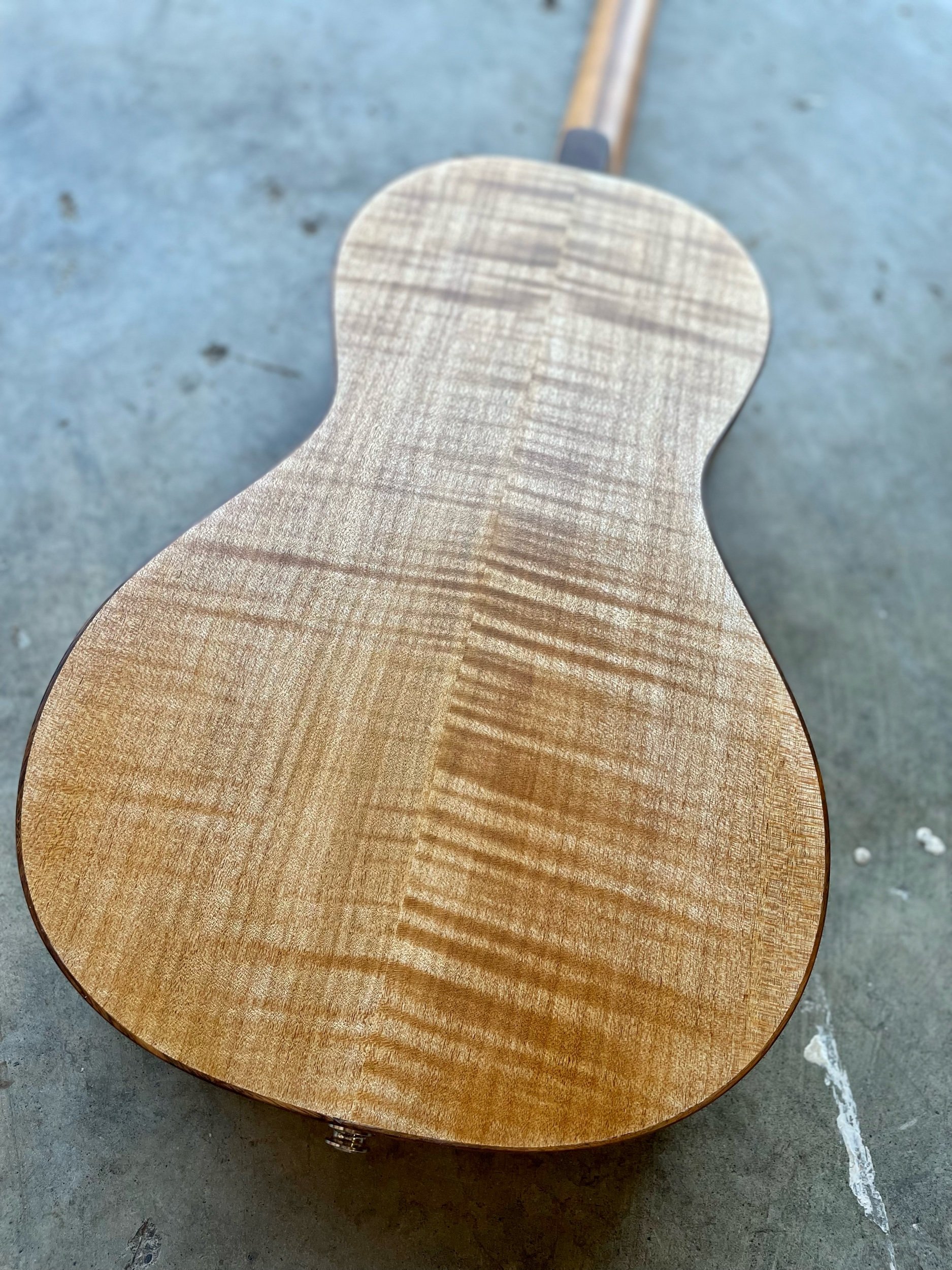Koa for a banjo? Why not? It’s a nice medium density hardwood, looks awesome and has a dark but vibrant sound. This Koa was imported to make clocks decades ago and has been waiting to be a banjo! I paired it with some Pistachio from California orchards that has some interesting beauty marks and a similar color palette. Open g tuning, goat skin head and brass arm rest finish it off. As always, I will donate to plant some future Koa trees to pay it forward.
#837- Redwood and Mahogany Tenor Ukulele
This is the 3rd of four matching ukes inspired by a wood salvage mission to a boat shop in Tacoma last year. The redwood top and mahogany back/sides/neck were all rescued on the same day. It is wrapped up in my random layout rope binding and features some crazy pistachio from California orchards. The sound is rich and warm but also punchy and detailed. I have enough for one more, drop me a line and I can build it for you.
#835- Mahogany Scout Ukulele
I was inspired by some salvaged Mahogany I had from slicing up our Tacoma boat shop slab to make this little scout ukulele. I think a Cedar neck and some local Walnut accents compliment it nicely. It is a loud little instrument, but also soft and sweet when needed. This scout is ready to head out into the world! It includes a well padded Kala soft shell case
#833- Spruce and Mahogany Tenor Ukulele
I was just explaining to my son how certain things go in and out of style (Crocs, fidget spinners, Pokémon) while other things seem to be…classic. (Levi’s, Tolkien, Miles Davis) I think Spruce and Mahogany is pretty darn classic. It makes me think of the thousands of 20th century American guitars made by Martin, Gibson, etc…and the countless songs strummed on them. I paired these two woods with some simple Pistachio and some rope binding. It has a low g and a pickup too. I love it. The Mahogany is salvaged from a boat shop in Tacoma, the Englemann Spruce is from a luthier’s estate sale and the Pistachio is from California orchards.
“Dear Aaron & Nicole,
I love this ukulele. Thank you both so much for your artistry, and attention to detail. I’m so very happy,
and will be saving for a short scale banjo next !
Best Regards,
A. R. ”
#827- Spruce and Curly Myrtle Alto Ukulele
Spruce and Myrtle has been popular in the shop lately. It’s loud, bright, sweet and mellow all at the same time. It also has a nice, bright color palette that stands out compared to all the brown ukes out there. The one piece Spruce top is from a Canadian drift log. The super Curly Myrtle back and sides are from the Oregon coast. The Spanish Cedar neck is from a retired builder. The grafted Pistachio is from California orchards.
“Dear Keim Family,
Just a quick note to thank you for everything. I have scarcely been able to put the ukulele down since it arrived earlier today.
This unique alto size is just what I’ve been seeking; at once bringing that traditional ukulele sound with the generous playability of a larger instrument. The wood combination works to bring a happy and balanced sound.
And it looks just beautiful. Aaron has an aesthetic that matches my own crafting these humble-looking pieces of playable art that, upon closer inspection, are actually full of thoughtful detail and understated elegance.
Thank you.
- K. M.
”
#832- Redwood and Mahogany Tenor Ukulele
This instrument is a close copy of one I made last year. The Redwood top and crazy Mahogany were both salvaged from a closing boat shop in Tacoma last fall. I used the same Mahogany for the neck as well. For the binding, we chose the random rope pattern that I make. The final flourish is the crazy Pistachio from woodfromthewest.com. I have another on order for next month and one more set of this Redwood and Mahogany on a shelf that is available. I love the sound of this combo and the aesthetic is certainly wild!
“Love it. I’ve been playing it almost exclusively.
It’s my wife’s favorite too.
I took a picture of both my Beansprout Ukes.
# 516 and # 832.
Thanks!
- D. K. ”
#830- Koa Tenor Ukulele
I had fun keeping it simple and natural with this one, featuring some humble clockmaker’s Koa from the Carpenter Ant stash. This sort of Koa often gets overlooked in favor of the fancy stuff, but it is still beautiful to me. Sounds great too! I complimented it with some simple Walnut binding, a Mahogany neck salvaged from a boat shop and Pistachio from California orchards.
“Dear Aaron and Nicole,
I have been seriously remiss on not sending a thank-you for my wonderful sounding ukulele. I love the way she smells and how she sounds.
This lovely ukulele has already given me hours of pleasure and I feel very lucky indeed to have one of your instruments. I am still thinking on names for my ukulele and when I figure that out I will send for a new tag with her name and number.
My best wishes,
- B.B.”
#831- Maple, Texas Ebony and Rosewood Tenor Banjo
This instrument started life in the 1920’s, probably as a banjo mandolin made in a Chicago factory. I got just the rim in a box of banjo parts from another builder and decided to make a new neck for it. The rim is Maple and Rosewood with a steel or nickel silver tone ring. I added a new skin head, brass tension hoop and brass hardware. I then made a new neck of Maple and Texas Ebony and finished the whole thing in amber shellac to match. It is all carefully done, but looks suitably antique, in my opinion. The neck has a carbon fiber truss rod for stability, geared tuners, a bone nut and a 20” scale.
#834- Maple, Mahogany and Pistachio Short Scale Banjo
My main banjo was the inspiration for this, with a bright sounding maple rim with brass tone ring, balanced out by a lighter weight Mahogany neck. I then stained the woods so they matched and added some fancy Pistachio for the fretboard and trim. This is a short scale (20”) banjo with an 11” rim. Very comfortable and fun to play. Non-steel strings and a Renaissance head for a classic sound. The Maple is from the Carpenter Ant stash and is scrap wood from our kitchen cabinets. The Mahogany is salvaged from my neighbor’s shop, a retired flute maker. The Pistachio is from California orchards.
“Dear Aaron and Nicole-
Just a note of thanks for another fabulous instrument! I’ve been playing clawhammer uke for years, and banjo has always been on my radar. The only deterrent was the length of a full scale, thus when Aaron took the plunge on developing a short scale model, I was all in!
The model itself is an ingenious design; capturing all aspects of true banjo tone while enabling multiple tunings. The neck feels wonderful, and an easier transition from uke than I had ever imagined.
Beansprout instruments are artistic pieces of beauty most appreciated in person vs photographs. I am truly in awe each day I open the case, and can’t stop smiling while playing. Oh what a blast!
Thanks again!
- J. K. ”
#829- Curly Koa Soprano Ukulele
It’s an eternal struggle for me to balance old and new ideas. I love the old Hawaiian instruments, but I also want to improve upon the past and try my own ideas. The Koa soprano is the perfect vehicle for that, as I strive for the vintage sparkle while adding some warmth and sustain. I also tried for that balance with the aesthetics, with traditional rope binding and classic Curly Koa with Pistachio and my modern shapes. The Koa body is from our friend’s sawmill on O’ahu, the Koa neck is from our friend Cath and the Pistachio is from California orchards. In order to pay back for using this Koa, we will donate to plant more trees through Saving Hawaii’s Forests.
“It has arrived. It’s unharmed, it’s gorgeous and it sounds fantastic. It has exactly the sound you were going for—hitting the target perfectly. Not too deep, not too high. Right in the sweet spot, encompassing both.
Aside from the sound being so great, the wood is really amazing. It’s almost like a lenticular photograph, looking different depending on the angle you look at it and the light hitting. From one angle, it looks like it’s made of pretty wood with a lovely, placid grain, but then either you or the light shifts a bit, and suddenly these bold, amazing tiger stripes appear.
It really made me think about the knowledge and instinct that goes into making instruments—of taking different woods with different qualities and bringing them into convergence with well-considered construction techniques to create a particularly sought-after sound. I marvel at the talent.
I remember years ago the late Robert Wheeler, famous for having 300 ukuleles, sat down with me and let me strum different ukuleles, both vintage and new, that he’d selected from his collection. He would tell me the wood used in the construction of a given ukulele, then let me play to hear the sound. Instruments of the same wood sounded different, and sometimes mahogany sounded like koa and koa sounded like mahogany. His point was that it’s more than just the wood. It’s the luthier.
I thought of that lesson while playing this uke. Ukuleles look the same more or less—give or take a fancy grain—and so when a lay person plays one, why ukes that look the same sound different is a mystery. And so, when a ukulele sounds truly wonderful, it seems like magic—as though something special has been instilled in it by a magician. I know it’s actually skill and knowledge and instinct and not magic. But it feels like magic. So I’ll think of it that way. Thanks for the magic, Aaron.
- B. R. ”
#828- Western Red Cedar and Curly Walnut Tenor Ukulele
Cedar and Walnut is a classic combination for us, but the endless variety keeps it fresh. The Walnut for this is from a stump I got from Zena forest products in Salem and milled into parts. It is curly, multi colored and has an asymmetrical inclusion that I love. I chose other parts that referenced that mark, including the streak in the neck blank, the grafted headplate and the unique fretboard. I also chose to accent everything with bright Maple as a nice contrast. The Cedar top is salvaged from wall panels. The Pistachio fretboard/headplate/bridge is from California orchards. The Douglas Fir neck is salvaged from the rebuilding center.
#823- Cherry and Texas Ebony Five String Banjo
This one looks simple at first, but the closer you look, the more you will find. The best example is the sliver of sapwood on the Texas Ebony fretboard, headplate and heel cap. I also find more to listen for as I play it, with little details hiding in the depth of its sound. It has a 12” rim, brass tone ring, synthetic head and non steel strings. The cherry is from the Carpenter Ant stash in Portland and the Texas Ebony is from a retired banjo builder.
#824- Spruce and Myrtle Tenor Ukulele
Crisp and sweet, loud and full, easy to play and completely unique. I love this tenor. The one piece Spruce top is from a drift log from British Columbia. The Myrtle is from the Carpenter Ant Stash in Portland. The Fir neck is a salvaged floor joist. The rest is Pistachio from California Orchards. I love instruments like this with a muted, earth tone color palette. The bird’s foot purfling looks like a brown line from far away, but up close reveals it’s tiny beauty. Low g, K&K pickup, geared tuners, bone nut and saddle and fluorocarbon strings.
#825- Spruce and Curly Maple Tenor Guitar
As I go further down the tenor guitar rabbit hole, I knew I would have to make one in this tuning, gdae. It’s an octave lower than a mandolin and lower then the original designer imagined. But, I knew I could sort out the bracing and the string gauges to make it work. My tenor guitar is based on an old Regal, with 21.5” scale, a floating bridge, tailpiece and steel strings. It’s a little bigger than a baritone uke. The curly Maple is from a violin maker, the Spruce is a drift log from British Columbia, the Mahogany was salvaged from a Tacoma boat shop and the Texas Ebony is from a retired banjo maker. I’m looking forward to making more of these!
“Hey guys, just wanted to let you know I received my tenor guitar yesterday after work and it is gorgeous! It sounds amazing in this tuning and it looks great, plays even better! Thank you so much for trying out something new!
- C. F. ”
#821- Walnut and Pistachio Five String Banjo
This banjo is a nice study of contrasts. First, we chose very simple, straight grain Walnut but added crazy grafted Pistachio to it. Second, we chose a big 12” rim, but made a custom short scale neck to it. It ended up lighter than my bigger banjos but still sits solidly in the lap. Despite the smaller neck, it still has a big, rich and haunting sound. The Walnut is from a retired furniture maker from Vashon Island and the Pistachio is from California Orchards.
“I picked up the banjo today and can confirm it arrived fully unharmed!!! It was honestly even more beautiful than I was expecting, and so smooth and comfortable to hold. I am enjoying getting familiar with it. I’m so glad I went with the non-steel strings too. The neck is very very comfortable and easy for me to play.
Thank you again,
- P.T. ”
#826- Port Orford Cedar and Curly Myrtle Tenor Ukulele
I’ve been struggling lately to describe to people what the tonal difference is between Western Red Cedar and Port Orford Cedar. Today, I figured out what makes sense to me: Red Cedar sounds red, like autumn colors and funny/sad memories. Port Orford Cedar sounds green, like springtime and wishing for summer vacation. Am I crazy? Don’t care, it makes sense to me. This one started with the awesome asymmetrical Myrtle back, giving me the color palette for the rest of the Uke. The Myrtle comes from a Portland tree that I milled. The Port Orford Cedar top comes from southern Oregon and the Pistachio fretboard/headplate/bridge come from California orchards, both via woodfromthewest.com. The simple Fir neck is salvaged from a floor joist. It just sounds green to me!
“Hi to Aaron and family. I wanted to let you know how much I’m enjoying my new uke (826). I received it Monday and have had three days with it.
No.1, it is without parallel for intonation, in my experience. I’m extremely picky about that. Also, this uke is the lightest tenor I’ve picked up, and it’s perfectly balanced.
...Thanks to all of you for your parts in all this.
- J. M. ”
#820- Figured Western Red Cedar and Curly Walnut Tenor Ukulele
I love building for a customer who is both a friend and an artist I admire. But, I have to admit it can create extra pressure and anxiety as well. It all combines to create an interesting emotional texture for the build process. It’s all just…deeper. But that’s what we want from art, something deeper. So I’ll let this one go to Avery Hill and see what magic she creates with it.
The top is some figured Cedar salvaged from a water tank on Vashon Island. It was cut well over 100 years ago and will now begin its third life as an ukulele. The neck is Fir salvaged from a floor joist. The rest is Walnut that I milled from a stump at Zena Forest Products in Salem. Cedar and Walnut are a standard combo for us. It has a loud, deep and rich sound with a breathy attack.
#819- Curly Myrtle Soprano Ukulele
Even after all this time, I still consider the Soprano to be one of the most challenging designs. It has to sound full and rich but retain the volume and charm of the old instruments. Myrtle is one of my favorite woods for this, because when I get it right it sounds familiar but unlike a Mahogany Martin or a Koa Kamaka. This Myrtle is from the Oregon coast via woodfromthewest.com. The neck is Spanish Cedar and the rest is Texas Ebony, both woods were salvaged from a builder’s estate. I chose a headstock shape from an 1890’s Santo instrument. It has a flat fretboard, bone nut/saddle, fluorocarbon strings, an endpin, a strap button and dots at 5/7/10 frets. It comes with a hard shell case. The cost is $1650 plus shipping.
“Hi, Aaron and Nicole.
The myrtle, Spanish cedar, and Texas ebony soprano showed up as scheduled today. It is a beautiful, light, and easy to play instrument. The curly myrtle tonewood shimmers in the light. The bound Texas ebony fretboard and Spanish cedar neck balance the body perfectly. It’s clear that you put a lot of craftsman sweat into the details on this instrument. I really like the historical reference in the Santo headstock that truly fits the soprano tradition. The endgraft is a finely detailed grace note to the whole! As someone who doesn’t waste wood, I really appreciate the beauty marks left by the branch nodes in the headplate.
Your Youtube comment on getting it all right is right on! The sound is warm, sweet, and clear when played softly and stays that way when you dig in. It plays very loud without distortion. The sustain is the longest of any soprano that I have ever played. My wife was astonished that such a light instrument gave such a rich sound!
Many thanks for your work on this soprano. It will be a delight to play this one for years to come.
Best regards,
- D. H. ”
#814- Hemlock and Maple Scout Ukulele
I’ve been so busy and also trying to rest, that I haven’t gotten a Scout out to the waiting list in a few months. We’ll, here you go. This one sounds cheerful and confident, I really like it. Hemlock top, maple back/sides, fir neck, oak binding and walnut fretboard/headplate/bridge. All shop scraps saved from the burn pile, ready to make music.
#817- Maple and Pistachio Five String Banjo
Maple! Classic banjo tone, solid feel in the lap, big volume, rich and sweet tone. I contrasted the Maple with some Pistachio from California Orchards. 12” rim, brass tone ring, goat skin head and a comfortable arm rest. All the maple is from the Carpenter Ant Stash in Portland.

